Criminal Law: Case Study Analysis of Manslaughter and Negligence
VerifiedAdded on 2022/08/15
|10
|2675
|24
Case Study
AI Summary
This document presents a detailed analysis of criminal law concepts through case studies. The assignment examines two primary scenarios: the first focuses on a case of manslaughter, where the defendant, Bumble, is accused of causing the death of Gargery. The analysis considers whether Bumble's defense is valid, examining the elements of manslaughter under the Criminal Code, including actus reus and mens rea, and determining Bumble's liability for involuntary manslaughter. The second case study involves Tiny Tim, who dies due to negligence. The analysis addresses the liability of Creakle, Fanny (Tiny Tim's nanny), and Flintwich (a municipal employee) for criminal negligence, considering their actions and omissions in relation to Tiny Tim's death and applying relevant sections of the Criminal Code. The assignment also defines criminal negligence, its legal tests, and the kind of evidence courts consider to prove negligence, with a discussion of cases related to parents' liability for leaving children in hot cars.
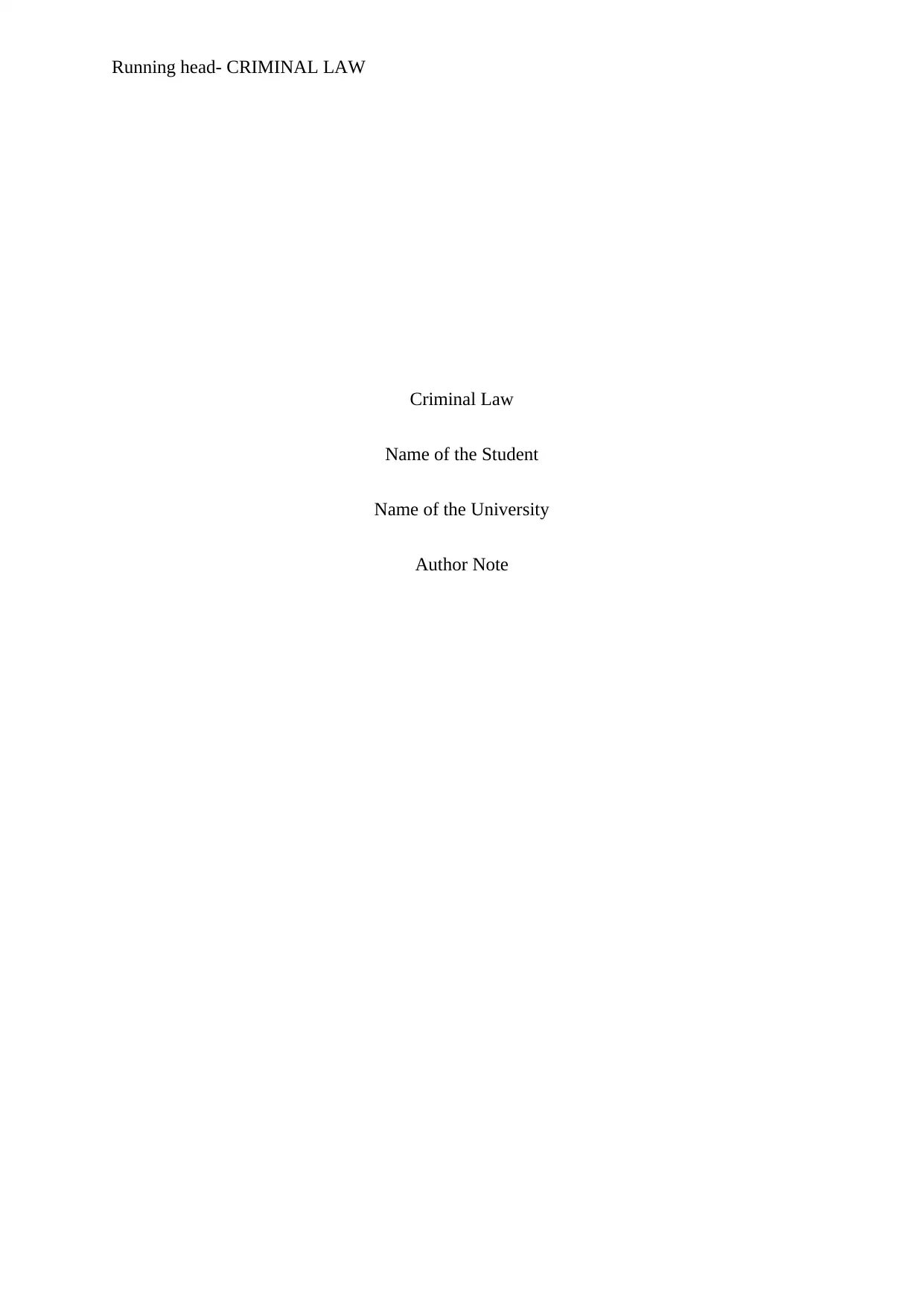
Running head- CRIMINAL LAW
Criminal Law
Name of the Student
Name of the University
Author Note
Criminal Law
Name of the Student
Name of the University
Author Note
Paraphrase This Document
Need a fresh take? Get an instant paraphrase of this document with our AI Paraphraser
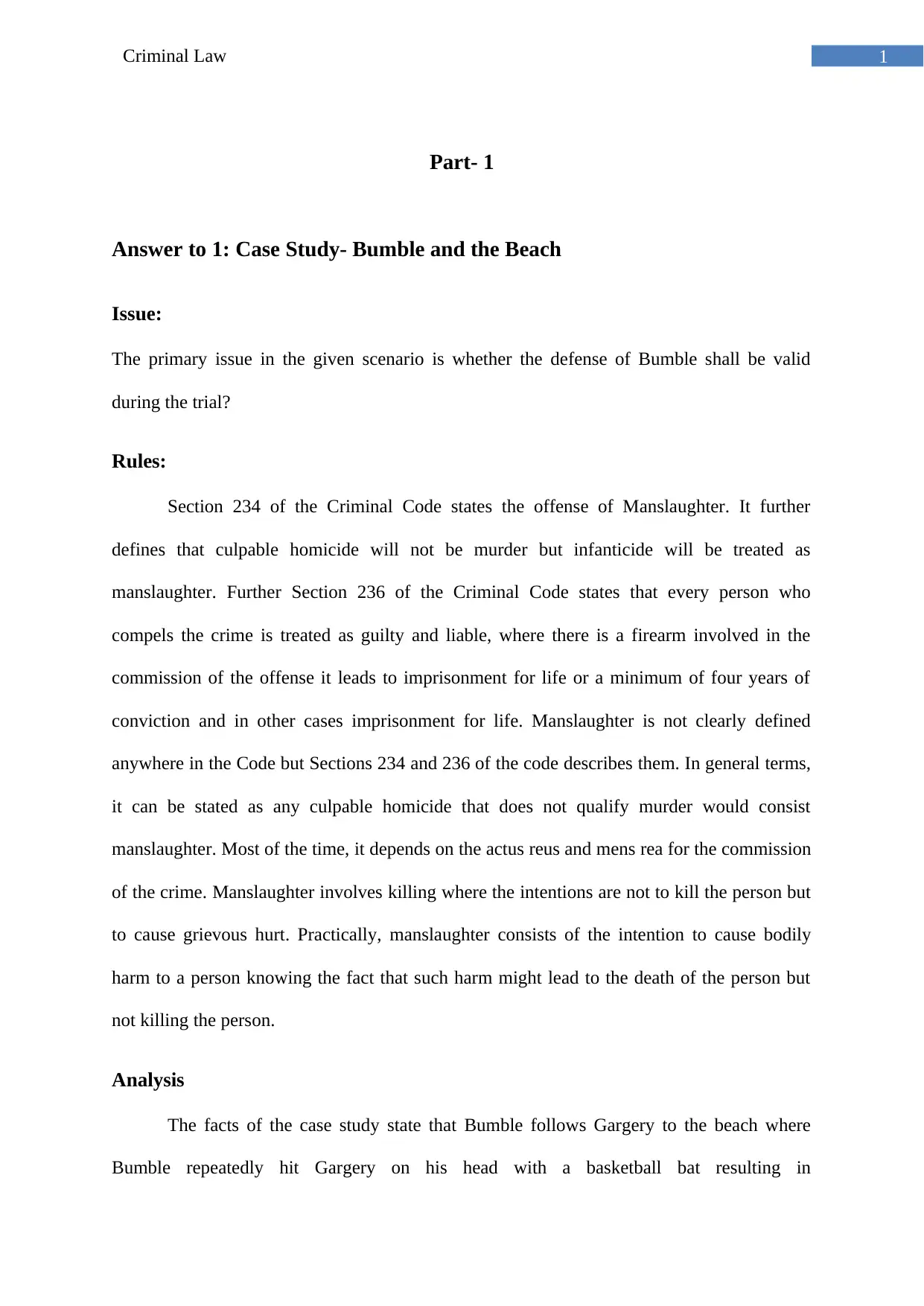
1Criminal Law
Part- 1
Answer to 1: Case Study- Bumble and the Beach
Issue:
The primary issue in the given scenario is whether the defense of Bumble shall be valid
during the trial?
Rules:
Section 234 of the Criminal Code states the offense of Manslaughter. It further
defines that culpable homicide will not be murder but infanticide will be treated as
manslaughter. Further Section 236 of the Criminal Code states that every person who
compels the crime is treated as guilty and liable, where there is a firearm involved in the
commission of the offense it leads to imprisonment for life or a minimum of four years of
conviction and in other cases imprisonment for life. Manslaughter is not clearly defined
anywhere in the Code but Sections 234 and 236 of the code describes them. In general terms,
it can be stated as any culpable homicide that does not qualify murder would consist
manslaughter. Most of the time, it depends on the actus reus and mens rea for the commission
of the crime. Manslaughter involves killing where the intentions are not to kill the person but
to cause grievous hurt. Practically, manslaughter consists of the intention to cause bodily
harm to a person knowing the fact that such harm might lead to the death of the person but
not killing the person.
Analysis
The facts of the case study state that Bumble follows Gargery to the beach where
Bumble repeatedly hit Gargery on his head with a basketball bat resulting in
Part- 1
Answer to 1: Case Study- Bumble and the Beach
Issue:
The primary issue in the given scenario is whether the defense of Bumble shall be valid
during the trial?
Rules:
Section 234 of the Criminal Code states the offense of Manslaughter. It further
defines that culpable homicide will not be murder but infanticide will be treated as
manslaughter. Further Section 236 of the Criminal Code states that every person who
compels the crime is treated as guilty and liable, where there is a firearm involved in the
commission of the offense it leads to imprisonment for life or a minimum of four years of
conviction and in other cases imprisonment for life. Manslaughter is not clearly defined
anywhere in the Code but Sections 234 and 236 of the code describes them. In general terms,
it can be stated as any culpable homicide that does not qualify murder would consist
manslaughter. Most of the time, it depends on the actus reus and mens rea for the commission
of the crime. Manslaughter involves killing where the intentions are not to kill the person but
to cause grievous hurt. Practically, manslaughter consists of the intention to cause bodily
harm to a person knowing the fact that such harm might lead to the death of the person but
not killing the person.
Analysis
The facts of the case study state that Bumble follows Gargery to the beach where
Bumble repeatedly hit Gargery on his head with a basketball bat resulting in
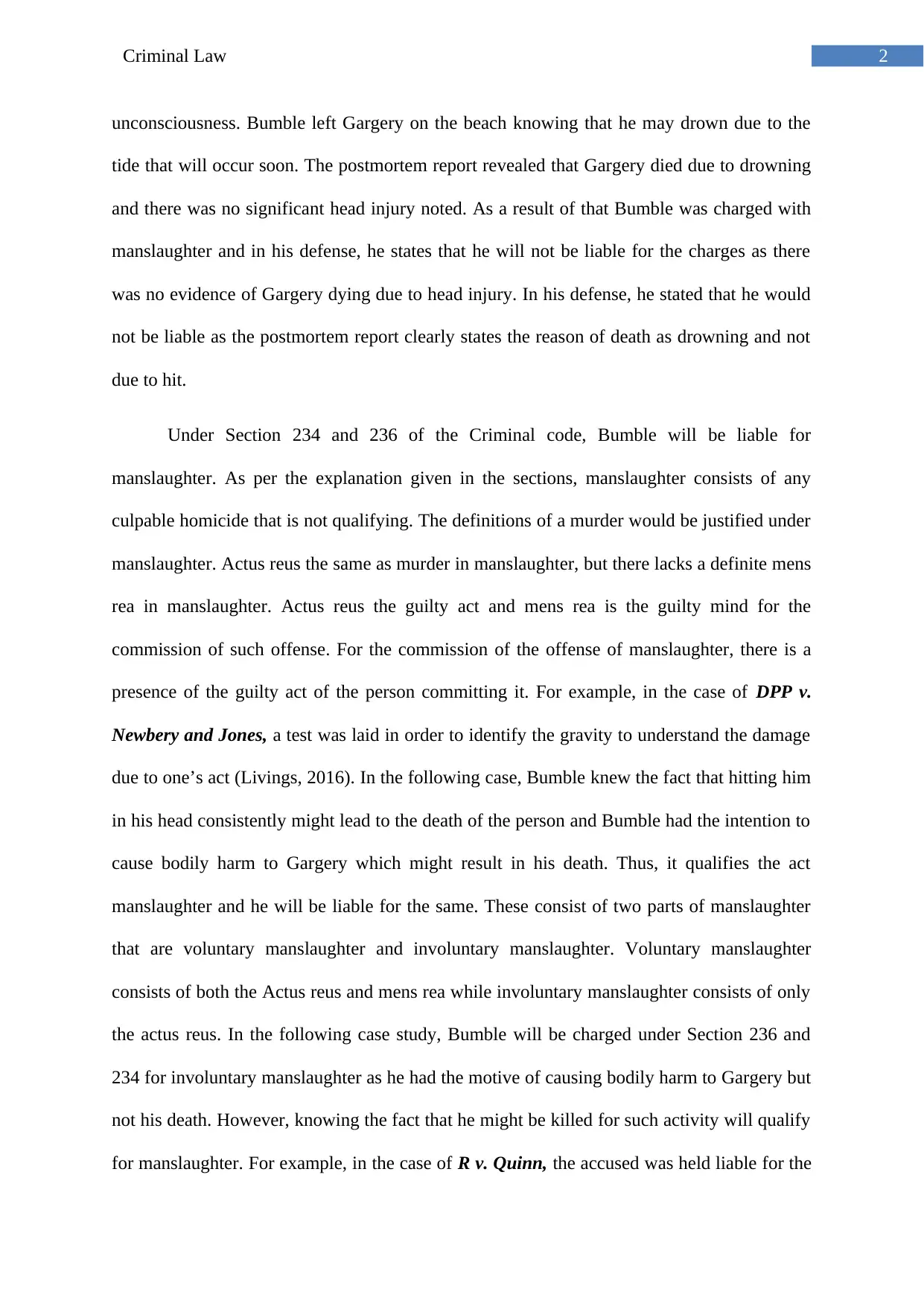
2Criminal Law
unconsciousness. Bumble left Gargery on the beach knowing that he may drown due to the
tide that will occur soon. The postmortem report revealed that Gargery died due to drowning
and there was no significant head injury noted. As a result of that Bumble was charged with
manslaughter and in his defense, he states that he will not be liable for the charges as there
was no evidence of Gargery dying due to head injury. In his defense, he stated that he would
not be liable as the postmortem report clearly states the reason of death as drowning and not
due to hit.
Under Section 234 and 236 of the Criminal code, Bumble will be liable for
manslaughter. As per the explanation given in the sections, manslaughter consists of any
culpable homicide that is not qualifying. The definitions of a murder would be justified under
manslaughter. Actus reus the same as murder in manslaughter, but there lacks a definite mens
rea in manslaughter. Actus reus the guilty act and mens rea is the guilty mind for the
commission of such offense. For the commission of the offense of manslaughter, there is a
presence of the guilty act of the person committing it. For example, in the case of DPP v.
Newbery and Jones, a test was laid in order to identify the gravity to understand the damage
due to one’s act (Livings, 2016). In the following case, Bumble knew the fact that hitting him
in his head consistently might lead to the death of the person and Bumble had the intention to
cause bodily harm to Gargery which might result in his death. Thus, it qualifies the act
manslaughter and he will be liable for the same. These consist of two parts of manslaughter
that are voluntary manslaughter and involuntary manslaughter. Voluntary manslaughter
consists of both the Actus reus and mens rea while involuntary manslaughter consists of only
the actus reus. In the following case study, Bumble will be charged under Section 236 and
234 for involuntary manslaughter as he had the motive of causing bodily harm to Gargery but
not his death. However, knowing the fact that he might be killed for such activity will qualify
for manslaughter. For example, in the case of R v. Quinn, the accused was held liable for the
unconsciousness. Bumble left Gargery on the beach knowing that he may drown due to the
tide that will occur soon. The postmortem report revealed that Gargery died due to drowning
and there was no significant head injury noted. As a result of that Bumble was charged with
manslaughter and in his defense, he states that he will not be liable for the charges as there
was no evidence of Gargery dying due to head injury. In his defense, he stated that he would
not be liable as the postmortem report clearly states the reason of death as drowning and not
due to hit.
Under Section 234 and 236 of the Criminal code, Bumble will be liable for
manslaughter. As per the explanation given in the sections, manslaughter consists of any
culpable homicide that is not qualifying. The definitions of a murder would be justified under
manslaughter. Actus reus the same as murder in manslaughter, but there lacks a definite mens
rea in manslaughter. Actus reus the guilty act and mens rea is the guilty mind for the
commission of such offense. For the commission of the offense of manslaughter, there is a
presence of the guilty act of the person committing it. For example, in the case of DPP v.
Newbery and Jones, a test was laid in order to identify the gravity to understand the damage
due to one’s act (Livings, 2016). In the following case, Bumble knew the fact that hitting him
in his head consistently might lead to the death of the person and Bumble had the intention to
cause bodily harm to Gargery which might result in his death. Thus, it qualifies the act
manslaughter and he will be liable for the same. These consist of two parts of manslaughter
that are voluntary manslaughter and involuntary manslaughter. Voluntary manslaughter
consists of both the Actus reus and mens rea while involuntary manslaughter consists of only
the actus reus. In the following case study, Bumble will be charged under Section 236 and
234 for involuntary manslaughter as he had the motive of causing bodily harm to Gargery but
not his death. However, knowing the fact that he might be killed for such activity will qualify
for manslaughter. For example, in the case of R v. Quinn, the accused was held liable for the
⊘ This is a preview!⊘
Do you want full access?
Subscribe today to unlock all pages.

Trusted by 1+ million students worldwide
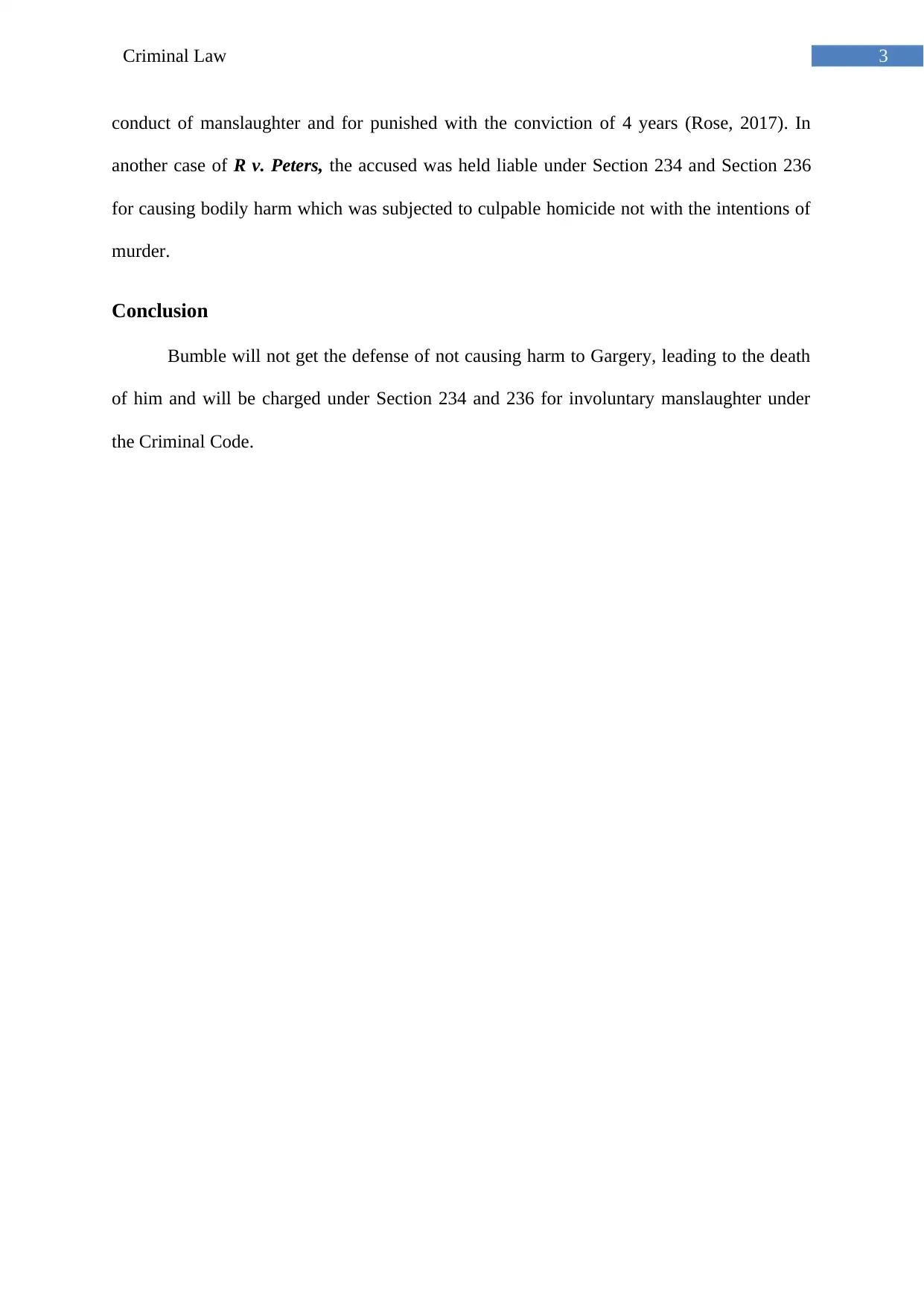
3Criminal Law
conduct of manslaughter and for punished with the conviction of 4 years (Rose, 2017). In
another case of R v. Peters, the accused was held liable under Section 234 and Section 236
for causing bodily harm which was subjected to culpable homicide not with the intentions of
murder.
Conclusion
Bumble will not get the defense of not causing harm to Gargery, leading to the death
of him and will be charged under Section 234 and 236 for involuntary manslaughter under
the Criminal Code.
conduct of manslaughter and for punished with the conviction of 4 years (Rose, 2017). In
another case of R v. Peters, the accused was held liable under Section 234 and Section 236
for causing bodily harm which was subjected to culpable homicide not with the intentions of
murder.
Conclusion
Bumble will not get the defense of not causing harm to Gargery, leading to the death
of him and will be charged under Section 234 and 236 for involuntary manslaughter under
the Criminal Code.
Paraphrase This Document
Need a fresh take? Get an instant paraphrase of this document with our AI Paraphraser
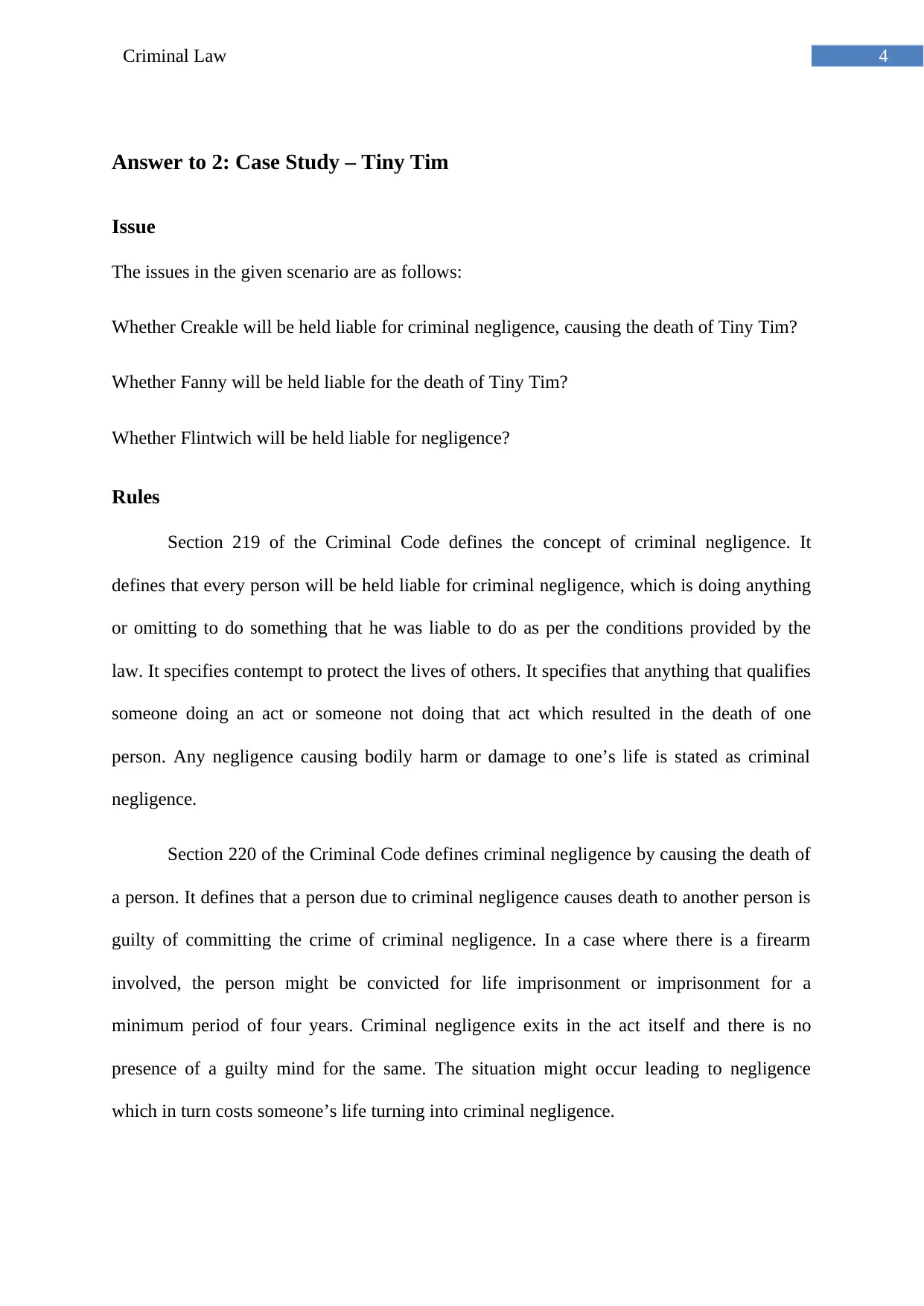
4Criminal Law
Answer to 2: Case Study – Tiny Tim
Issue
The issues in the given scenario are as follows:
Whether Creakle will be held liable for criminal negligence, causing the death of Tiny Tim?
Whether Fanny will be held liable for the death of Tiny Tim?
Whether Flintwich will be held liable for negligence?
Rules
Section 219 of the Criminal Code defines the concept of criminal negligence. It
defines that every person will be held liable for criminal negligence, which is doing anything
or omitting to do something that he was liable to do as per the conditions provided by the
law. It specifies contempt to protect the lives of others. It specifies that anything that qualifies
someone doing an act or someone not doing that act which resulted in the death of one
person. Any negligence causing bodily harm or damage to one’s life is stated as criminal
negligence.
Section 220 of the Criminal Code defines criminal negligence by causing the death of
a person. It defines that a person due to criminal negligence causes death to another person is
guilty of committing the crime of criminal negligence. In a case where there is a firearm
involved, the person might be convicted for life imprisonment or imprisonment for a
minimum period of four years. Criminal negligence exits in the act itself and there is no
presence of a guilty mind for the same. The situation might occur leading to negligence
which in turn costs someone’s life turning into criminal negligence.
Answer to 2: Case Study – Tiny Tim
Issue
The issues in the given scenario are as follows:
Whether Creakle will be held liable for criminal negligence, causing the death of Tiny Tim?
Whether Fanny will be held liable for the death of Tiny Tim?
Whether Flintwich will be held liable for negligence?
Rules
Section 219 of the Criminal Code defines the concept of criminal negligence. It
defines that every person will be held liable for criminal negligence, which is doing anything
or omitting to do something that he was liable to do as per the conditions provided by the
law. It specifies contempt to protect the lives of others. It specifies that anything that qualifies
someone doing an act or someone not doing that act which resulted in the death of one
person. Any negligence causing bodily harm or damage to one’s life is stated as criminal
negligence.
Section 220 of the Criminal Code defines criminal negligence by causing the death of
a person. It defines that a person due to criminal negligence causes death to another person is
guilty of committing the crime of criminal negligence. In a case where there is a firearm
involved, the person might be convicted for life imprisonment or imprisonment for a
minimum period of four years. Criminal negligence exits in the act itself and there is no
presence of a guilty mind for the same. The situation might occur leading to negligence
which in turn costs someone’s life turning into criminal negligence.
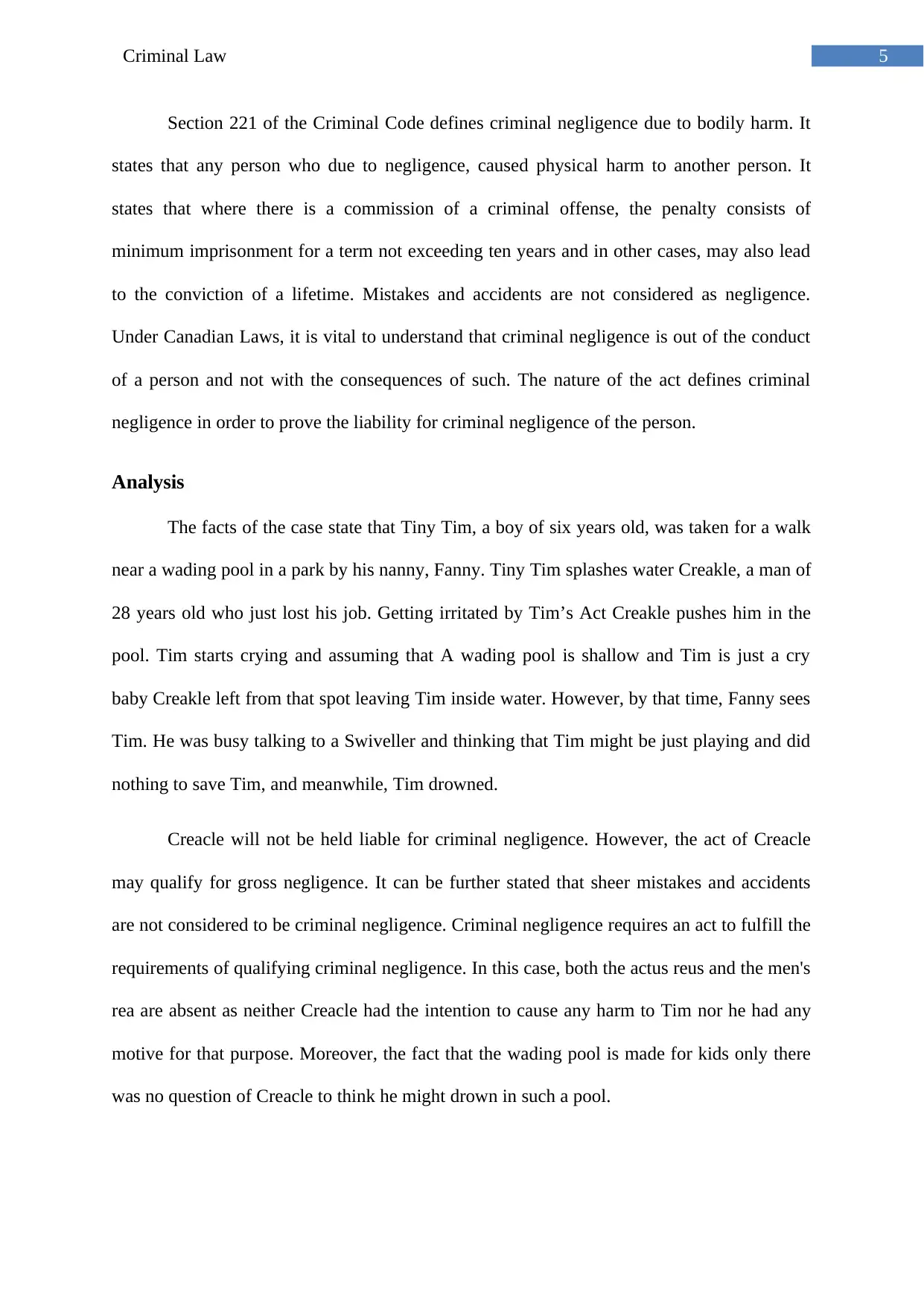
5Criminal Law
Section 221 of the Criminal Code defines criminal negligence due to bodily harm. It
states that any person who due to negligence, caused physical harm to another person. It
states that where there is a commission of a criminal offense, the penalty consists of
minimum imprisonment for a term not exceeding ten years and in other cases, may also lead
to the conviction of a lifetime. Mistakes and accidents are not considered as negligence.
Under Canadian Laws, it is vital to understand that criminal negligence is out of the conduct
of a person and not with the consequences of such. The nature of the act defines criminal
negligence in order to prove the liability for criminal negligence of the person.
Analysis
The facts of the case state that Tiny Tim, a boy of six years old, was taken for a walk
near a wading pool in a park by his nanny, Fanny. Tiny Tim splashes water Creakle, a man of
28 years old who just lost his job. Getting irritated by Tim’s Act Creakle pushes him in the
pool. Tim starts crying and assuming that A wading pool is shallow and Tim is just a cry
baby Creakle left from that spot leaving Tim inside water. However, by that time, Fanny sees
Tim. He was busy talking to a Swiveller and thinking that Tim might be just playing and did
nothing to save Tim, and meanwhile, Tim drowned.
Creacle will not be held liable for criminal negligence. However, the act of Creacle
may qualify for gross negligence. It can be further stated that sheer mistakes and accidents
are not considered to be criminal negligence. Criminal negligence requires an act to fulfill the
requirements of qualifying criminal negligence. In this case, both the actus reus and the men's
rea are absent as neither Creacle had the intention to cause any harm to Tim nor he had any
motive for that purpose. Moreover, the fact that the wading pool is made for kids only there
was no question of Creacle to think he might drown in such a pool.
Section 221 of the Criminal Code defines criminal negligence due to bodily harm. It
states that any person who due to negligence, caused physical harm to another person. It
states that where there is a commission of a criminal offense, the penalty consists of
minimum imprisonment for a term not exceeding ten years and in other cases, may also lead
to the conviction of a lifetime. Mistakes and accidents are not considered as negligence.
Under Canadian Laws, it is vital to understand that criminal negligence is out of the conduct
of a person and not with the consequences of such. The nature of the act defines criminal
negligence in order to prove the liability for criminal negligence of the person.
Analysis
The facts of the case state that Tiny Tim, a boy of six years old, was taken for a walk
near a wading pool in a park by his nanny, Fanny. Tiny Tim splashes water Creakle, a man of
28 years old who just lost his job. Getting irritated by Tim’s Act Creakle pushes him in the
pool. Tim starts crying and assuming that A wading pool is shallow and Tim is just a cry
baby Creakle left from that spot leaving Tim inside water. However, by that time, Fanny sees
Tim. He was busy talking to a Swiveller and thinking that Tim might be just playing and did
nothing to save Tim, and meanwhile, Tim drowned.
Creacle will not be held liable for criminal negligence. However, the act of Creacle
may qualify for gross negligence. It can be further stated that sheer mistakes and accidents
are not considered to be criminal negligence. Criminal negligence requires an act to fulfill the
requirements of qualifying criminal negligence. In this case, both the actus reus and the men's
rea are absent as neither Creacle had the intention to cause any harm to Tim nor he had any
motive for that purpose. Moreover, the fact that the wading pool is made for kids only there
was no question of Creacle to think he might drown in such a pool.
⊘ This is a preview!⊘
Do you want full access?
Subscribe today to unlock all pages.

Trusted by 1+ million students worldwide
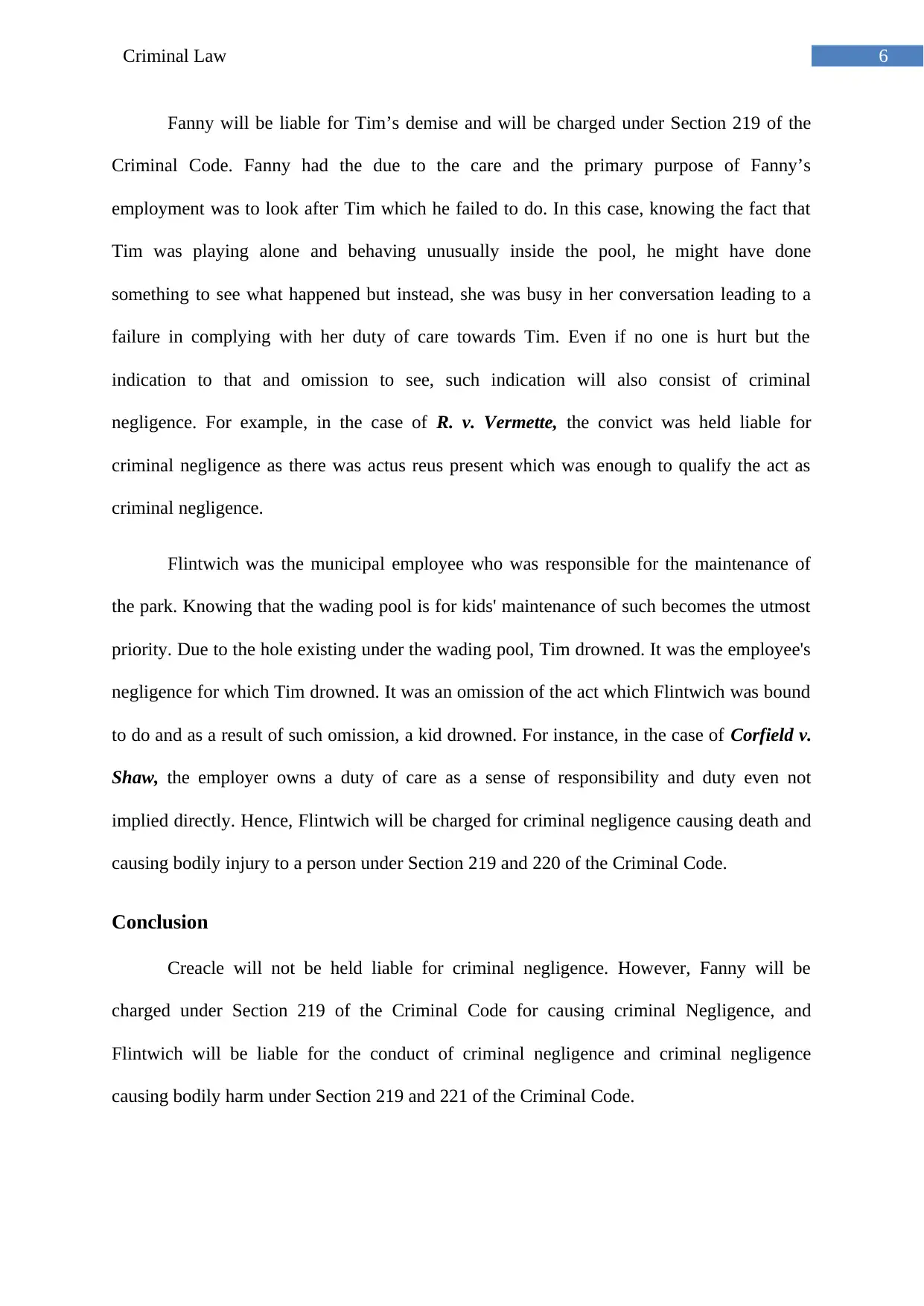
6Criminal Law
Fanny will be liable for Tim’s demise and will be charged under Section 219 of the
Criminal Code. Fanny had the due to the care and the primary purpose of Fanny’s
employment was to look after Tim which he failed to do. In this case, knowing the fact that
Tim was playing alone and behaving unusually inside the pool, he might have done
something to see what happened but instead, she was busy in her conversation leading to a
failure in complying with her duty of care towards Tim. Even if no one is hurt but the
indication to that and omission to see, such indication will also consist of criminal
negligence. For example, in the case of R. v. Vermette, the convict was held liable for
criminal negligence as there was actus reus present which was enough to qualify the act as
criminal negligence.
Flintwich was the municipal employee who was responsible for the maintenance of
the park. Knowing that the wading pool is for kids' maintenance of such becomes the utmost
priority. Due to the hole existing under the wading pool, Tim drowned. It was the employee's
negligence for which Tim drowned. It was an omission of the act which Flintwich was bound
to do and as a result of such omission, a kid drowned. For instance, in the case of Corfield v.
Shaw, the employer owns a duty of care as a sense of responsibility and duty even not
implied directly. Hence, Flintwich will be charged for criminal negligence causing death and
causing bodily injury to a person under Section 219 and 220 of the Criminal Code.
Conclusion
Creacle will not be held liable for criminal negligence. However, Fanny will be
charged under Section 219 of the Criminal Code for causing criminal Negligence, and
Flintwich will be liable for the conduct of criminal negligence and criminal negligence
causing bodily harm under Section 219 and 221 of the Criminal Code.
Fanny will be liable for Tim’s demise and will be charged under Section 219 of the
Criminal Code. Fanny had the due to the care and the primary purpose of Fanny’s
employment was to look after Tim which he failed to do. In this case, knowing the fact that
Tim was playing alone and behaving unusually inside the pool, he might have done
something to see what happened but instead, she was busy in her conversation leading to a
failure in complying with her duty of care towards Tim. Even if no one is hurt but the
indication to that and omission to see, such indication will also consist of criminal
negligence. For example, in the case of R. v. Vermette, the convict was held liable for
criminal negligence as there was actus reus present which was enough to qualify the act as
criminal negligence.
Flintwich was the municipal employee who was responsible for the maintenance of
the park. Knowing that the wading pool is for kids' maintenance of such becomes the utmost
priority. Due to the hole existing under the wading pool, Tim drowned. It was the employee's
negligence for which Tim drowned. It was an omission of the act which Flintwich was bound
to do and as a result of such omission, a kid drowned. For instance, in the case of Corfield v.
Shaw, the employer owns a duty of care as a sense of responsibility and duty even not
implied directly. Hence, Flintwich will be charged for criminal negligence causing death and
causing bodily injury to a person under Section 219 and 220 of the Criminal Code.
Conclusion
Creacle will not be held liable for criminal negligence. However, Fanny will be
charged under Section 219 of the Criminal Code for causing criminal Negligence, and
Flintwich will be liable for the conduct of criminal negligence and criminal negligence
causing bodily harm under Section 219 and 221 of the Criminal Code.
Paraphrase This Document
Need a fresh take? Get an instant paraphrase of this document with our AI Paraphraser
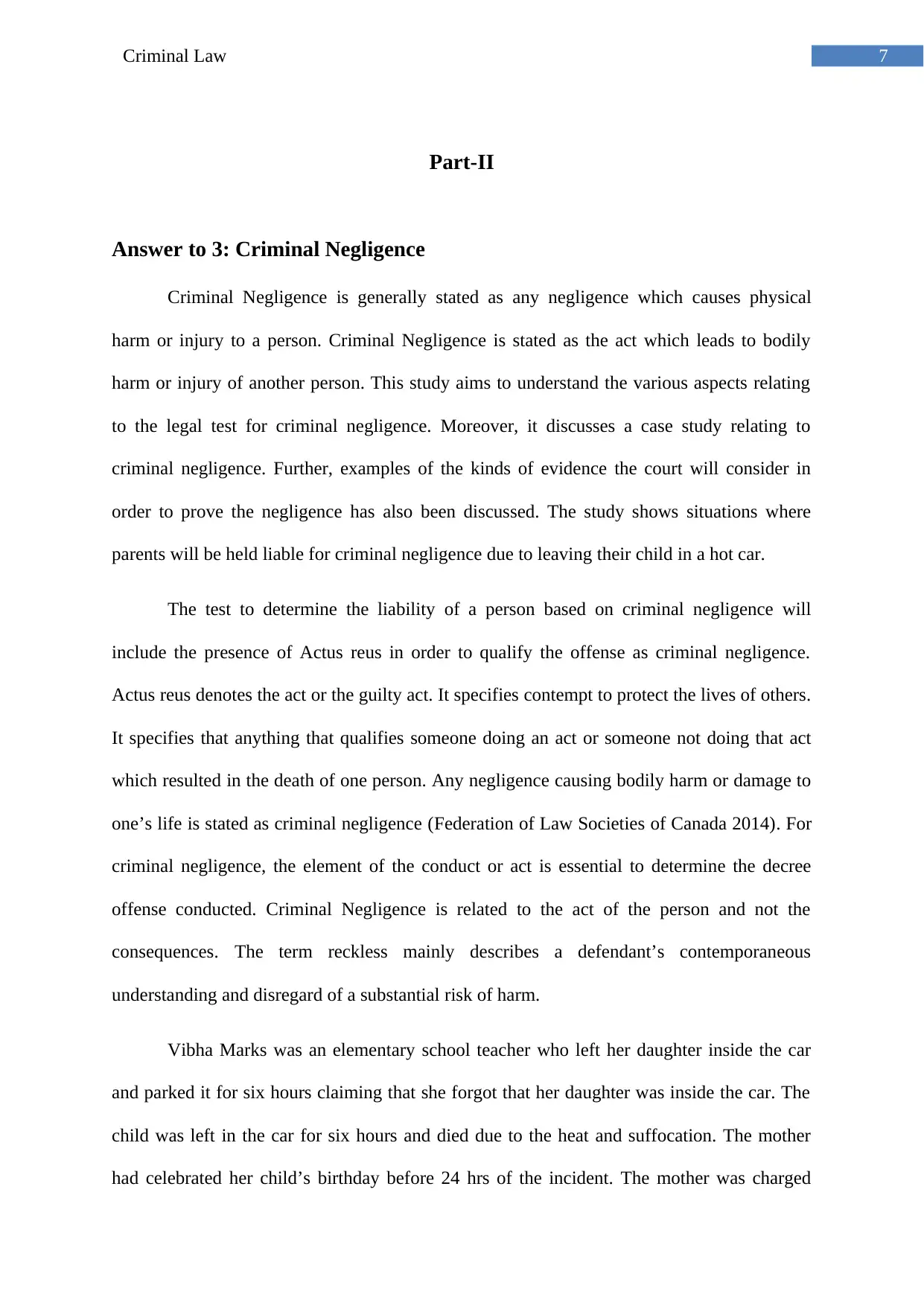
7Criminal Law
Part-II
Answer to 3: Criminal Negligence
Criminal Negligence is generally stated as any negligence which causes physical
harm or injury to a person. Criminal Negligence is stated as the act which leads to bodily
harm or injury of another person. This study aims to understand the various aspects relating
to the legal test for criminal negligence. Moreover, it discusses a case study relating to
criminal negligence. Further, examples of the kinds of evidence the court will consider in
order to prove the negligence has also been discussed. The study shows situations where
parents will be held liable for criminal negligence due to leaving their child in a hot car.
The test to determine the liability of a person based on criminal negligence will
include the presence of Actus reus in order to qualify the offense as criminal negligence.
Actus reus denotes the act or the guilty act. It specifies contempt to protect the lives of others.
It specifies that anything that qualifies someone doing an act or someone not doing that act
which resulted in the death of one person. Any negligence causing bodily harm or damage to
one’s life is stated as criminal negligence (Federation of Law Societies of Canada 2014). For
criminal negligence, the element of the conduct or act is essential to determine the decree
offense conducted. Criminal Negligence is related to the act of the person and not the
consequences. “The term reckless mainly describes a defendant’s contemporaneous
understanding and disregard of a substantial risk of harm.
Vibha Marks was an elementary school teacher who left her daughter inside the car
and parked it for six hours claiming that she forgot that her daughter was inside the car. The
child was left in the car for six hours and died due to the heat and suffocation. The mother
had celebrated her child’s birthday before 24 hrs of the incident. The mother was charged
Part-II
Answer to 3: Criminal Negligence
Criminal Negligence is generally stated as any negligence which causes physical
harm or injury to a person. Criminal Negligence is stated as the act which leads to bodily
harm or injury of another person. This study aims to understand the various aspects relating
to the legal test for criminal negligence. Moreover, it discusses a case study relating to
criminal negligence. Further, examples of the kinds of evidence the court will consider in
order to prove the negligence has also been discussed. The study shows situations where
parents will be held liable for criminal negligence due to leaving their child in a hot car.
The test to determine the liability of a person based on criminal negligence will
include the presence of Actus reus in order to qualify the offense as criminal negligence.
Actus reus denotes the act or the guilty act. It specifies contempt to protect the lives of others.
It specifies that anything that qualifies someone doing an act or someone not doing that act
which resulted in the death of one person. Any negligence causing bodily harm or damage to
one’s life is stated as criminal negligence (Federation of Law Societies of Canada 2014). For
criminal negligence, the element of the conduct or act is essential to determine the decree
offense conducted. Criminal Negligence is related to the act of the person and not the
consequences. “The term reckless mainly describes a defendant’s contemporaneous
understanding and disregard of a substantial risk of harm.
Vibha Marks was an elementary school teacher who left her daughter inside the car
and parked it for six hours claiming that she forgot that her daughter was inside the car. The
child was left in the car for six hours and died due to the heat and suffocation. The mother
had celebrated her child’s birthday before 24 hrs of the incident. The mother was charged
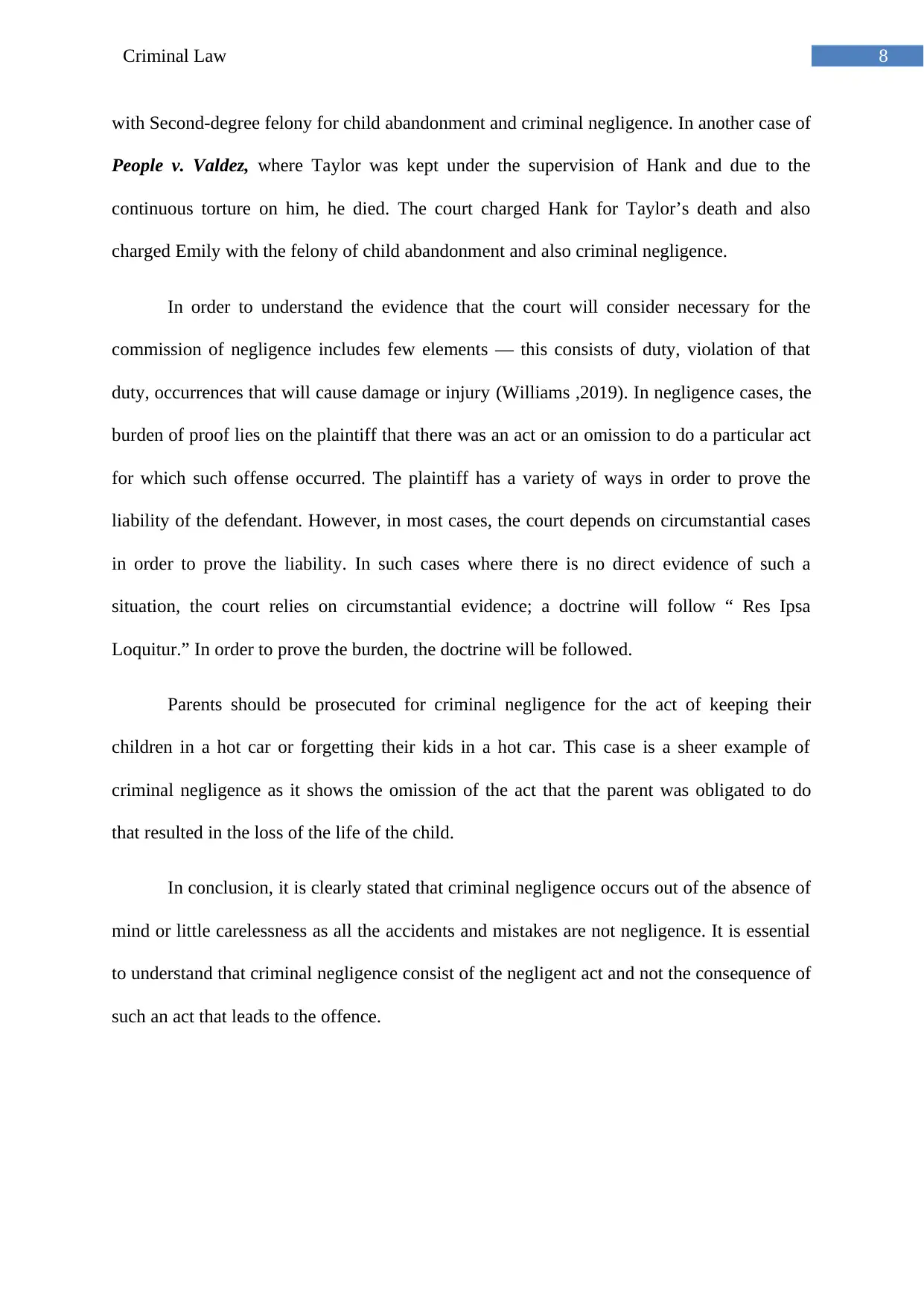
8Criminal Law
with Second-degree felony for child abandonment and criminal negligence. In another case of
People v. Valdez, where Taylor was kept under the supervision of Hank and due to the
continuous torture on him, he died. The court charged Hank for Taylor’s death and also
charged Emily with the felony of child abandonment and also criminal negligence.
In order to understand the evidence that the court will consider necessary for the
commission of negligence includes few elements — this consists of duty, violation of that
duty, occurrences that will cause damage or injury (Williams ,2019). In negligence cases, the
burden of proof lies on the plaintiff that there was an act or an omission to do a particular act
for which such offense occurred. The plaintiff has a variety of ways in order to prove the
liability of the defendant. However, in most cases, the court depends on circumstantial cases
in order to prove the liability. In such cases where there is no direct evidence of such a
situation, the court relies on circumstantial evidence; a doctrine will follow “ Res Ipsa
Loquitur.” In order to prove the burden, the doctrine will be followed.
Parents should be prosecuted for criminal negligence for the act of keeping their
children in a hot car or forgetting their kids in a hot car. This case is a sheer example of
criminal negligence as it shows the omission of the act that the parent was obligated to do
that resulted in the loss of the life of the child.
In conclusion, it is clearly stated that criminal negligence occurs out of the absence of
mind or little carelessness as all the accidents and mistakes are not negligence. It is essential
to understand that criminal negligence consist of the negligent act and not the consequence of
such an act that leads to the offence.
with Second-degree felony for child abandonment and criminal negligence. In another case of
People v. Valdez, where Taylor was kept under the supervision of Hank and due to the
continuous torture on him, he died. The court charged Hank for Taylor’s death and also
charged Emily with the felony of child abandonment and also criminal negligence.
In order to understand the evidence that the court will consider necessary for the
commission of negligence includes few elements — this consists of duty, violation of that
duty, occurrences that will cause damage or injury (Williams ,2019). In negligence cases, the
burden of proof lies on the plaintiff that there was an act or an omission to do a particular act
for which such offense occurred. The plaintiff has a variety of ways in order to prove the
liability of the defendant. However, in most cases, the court depends on circumstantial cases
in order to prove the liability. In such cases where there is no direct evidence of such a
situation, the court relies on circumstantial evidence; a doctrine will follow “ Res Ipsa
Loquitur.” In order to prove the burden, the doctrine will be followed.
Parents should be prosecuted for criminal negligence for the act of keeping their
children in a hot car or forgetting their kids in a hot car. This case is a sheer example of
criminal negligence as it shows the omission of the act that the parent was obligated to do
that resulted in the loss of the life of the child.
In conclusion, it is clearly stated that criminal negligence occurs out of the absence of
mind or little carelessness as all the accidents and mistakes are not negligence. It is essential
to understand that criminal negligence consist of the negligent act and not the consequence of
such an act that leads to the offence.
⊘ This is a preview!⊘
Do you want full access?
Subscribe today to unlock all pages.

Trusted by 1+ million students worldwide
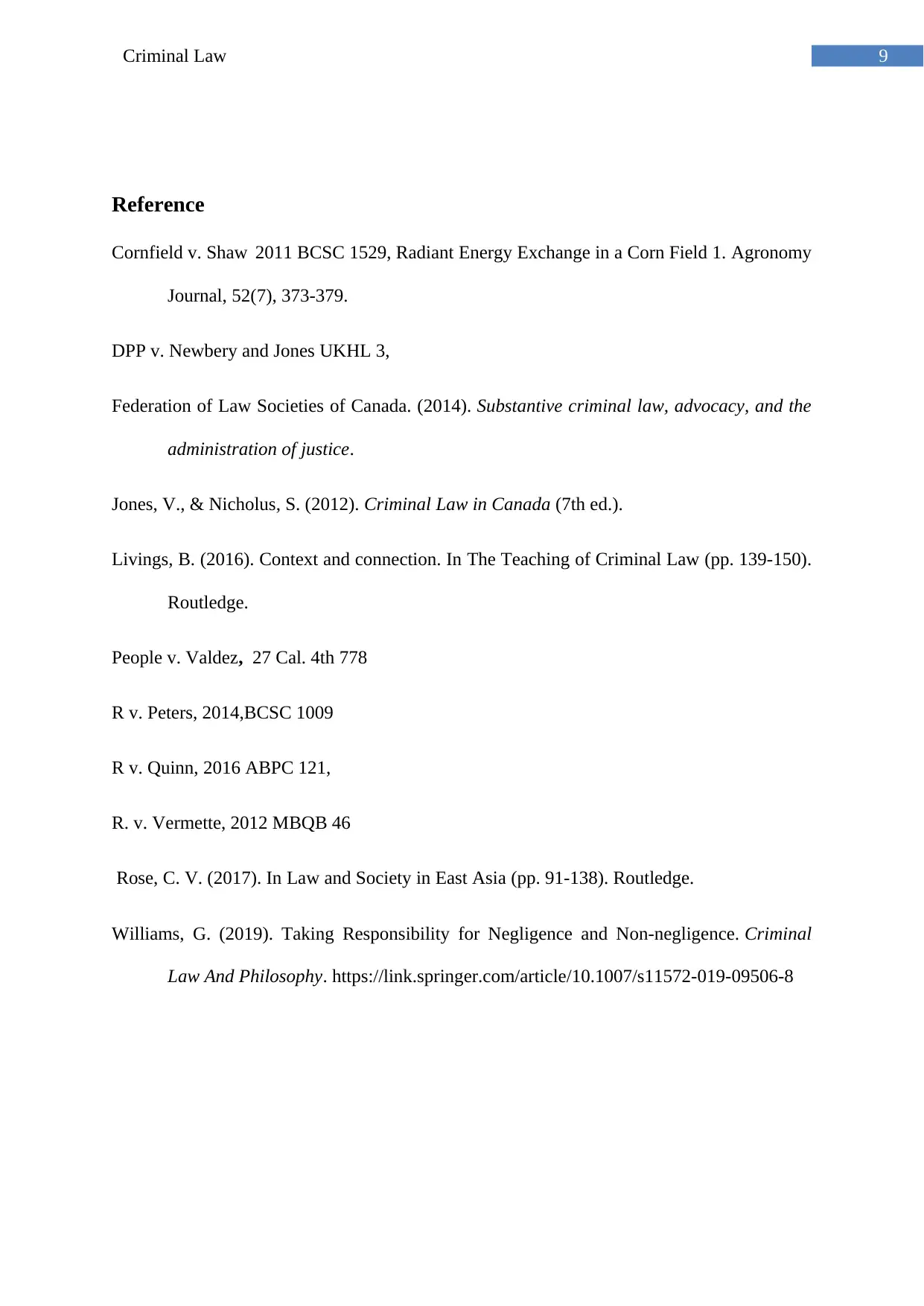
9Criminal Law
Reference
Cornfield v. Shaw 2011 BCSC 1529, Radiant Energy Exchange in a Corn Field 1. Agronomy
Journal, 52(7), 373-379.
DPP v. Newbery and Jones UKHL 3,
Federation of Law Societies of Canada. (2014). Substantive criminal law, advocacy, and the
administration of justice.
Jones, V., & Nicholus, S. (2012). Criminal Law in Canada (7th ed.).
Livings, B. (2016). Context and connection. In The Teaching of Criminal Law (pp. 139-150).
Routledge.
People v. Valdez, 27 Cal. 4th 778
R v. Peters, 2014,BCSC 1009
R v. Quinn, 2016 ABPC 121,
R. v. Vermette, 2012 MBQB 46
Rose, C. V. (2017). In Law and Society in East Asia (pp. 91-138). Routledge.
Williams, G. (2019). Taking Responsibility for Negligence and Non-negligence. Criminal
Law And Philosophy. https://link.springer.com/article/10.1007/s11572-019-09506-8
Reference
Cornfield v. Shaw 2011 BCSC 1529, Radiant Energy Exchange in a Corn Field 1. Agronomy
Journal, 52(7), 373-379.
DPP v. Newbery and Jones UKHL 3,
Federation of Law Societies of Canada. (2014). Substantive criminal law, advocacy, and the
administration of justice.
Jones, V., & Nicholus, S. (2012). Criminal Law in Canada (7th ed.).
Livings, B. (2016). Context and connection. In The Teaching of Criminal Law (pp. 139-150).
Routledge.
People v. Valdez, 27 Cal. 4th 778
R v. Peters, 2014,BCSC 1009
R v. Quinn, 2016 ABPC 121,
R. v. Vermette, 2012 MBQB 46
Rose, C. V. (2017). In Law and Society in East Asia (pp. 91-138). Routledge.
Williams, G. (2019). Taking Responsibility for Negligence and Non-negligence. Criminal
Law And Philosophy. https://link.springer.com/article/10.1007/s11572-019-09506-8
1 out of 10
Related Documents
Your All-in-One AI-Powered Toolkit for Academic Success.
+13062052269
info@desklib.com
Available 24*7 on WhatsApp / Email
![[object Object]](/_next/static/media/star-bottom.7253800d.svg)
Unlock your academic potential
Copyright © 2020–2025 A2Z Services. All Rights Reserved. Developed and managed by ZUCOL.





